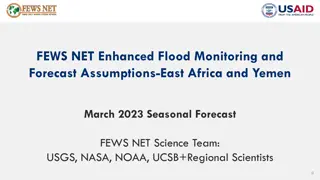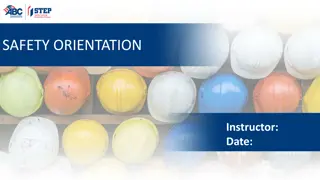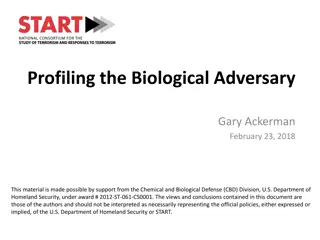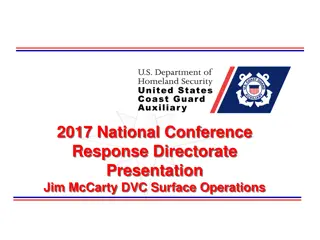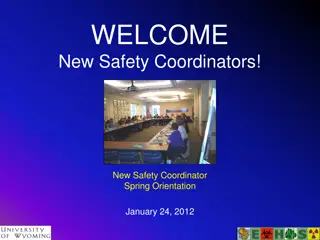Guide to UCSB Biological Safety Program
This guide provides an overview of UCSB's Biological Safety Program, covering important aspects such as lab safety fundamentals, biological use authorization, biosafety officer's role, and the Institutional Biosafety Committee. It outlines key steps like hazard assessment, training, waste management, and the importance of institutional approvals for specific projects. For a comprehensive understanding of biological safety at UCSB, refer to this informative guide.
Download Presentation

Please find below an Image/Link to download the presentation.
The content on the website is provided AS IS for your information and personal use only. It may not be sold, licensed, or shared on other websites without obtaining consent from the author.If you encounter any issues during the download, it is possible that the publisher has removed the file from their server.
You are allowed to download the files provided on this website for personal or commercial use, subject to the condition that they are used lawfully. All files are the property of their respective owners.
The content on the website is provided AS IS for your information and personal use only. It may not be sold, licensed, or shared on other websites without obtaining consent from the author.
E N D
Presentation Transcript
07/19/2024 A guide to UCSB s Biological Safety Program https://www.ehs.ucsb.edu/programs-services/biological-safety Biological Safety/Environmental Health and Safety/Design, Facilities and Safety Services
Checklist The Biological Safety Program in the Context of Research Safety Lab Safety and Chemical Hygiene: Lab Safety Fundamentals online or in person Lab Hazard Assessment on the Risk and Safety Solutions application Pick up lab coats prescribed by the Lab Hazard Assessment Chemical Hygiene Plan Training Needs Assessment Form for each group member Update door placards with emergency contact information and lab hazards Post emergency flipcharts Create laboratory-specific SOPs Complete additional training Biological Use: Obtain Biological Use Authorization (BUA) for projects involving certain biological materials Organize a walkthrough with the Biosafety Officer after BUA completion Other Institutional approvals are required for work with stem cells, vertebrates, human subjects Biological Safety/Environmental Health and Safety/Design, Facilities and Safety Services
Biosafety Officer (BS0) Reviews, consults on biological lab spaces Coordinates the Institutional Biosafety Committee Logs inspections after biological use authorization approval Explains campus waste practices Advises on containment practices Provides biohazard labels and signage when needed Provides secondary biohazardous waste collection containers, autoclave bags and accumulation bins to new faculty or those establishing a medical waste stream Provides biohazardous sharps waste containers to new lab and field research faculty Biosafety@ehs.ucsb.edu or Bishop@ucsb.edu These slides are not a substitute for a discussion about your research or correspondence with the BSO, but they may answer some of your questions and serve as a reference Biological Safety/Environmental Health and Safety/Design, Facilities and Safety Services
Institutional Biosafety Committee (IBC) A requirement of the NIH Guidelines is that an Institutional Biosafety Committee (IBC) reviews and approves research that is covered by the NIH Guidelines for local review and oversight In addition to the research covered by the NIH Guidelines, the UCSB Biosafety Committee also reviews research protocols with wild type infectious agents, human tissues and excreta The IBC is comprised of UC Santa Barbara tenured or tenure-track faculty, subject matter experts, safety professionals, and includes unaffiliated individuals who represent community interests IBC composition complies with the requirements of the NIH Guidelines. Biological Safety/Environmental Health and Safety/Design, Facilities and Safety Services
NIH Guidelines for Research Involving Recombinant or Synthetic Nucleic Acid Molecules Introduction: The NIH Guidelines for Research Involving Recombinant and Synthetic Nucleic Acid Molecules detail procedures and practices for the containment and safe conduct of research with recombinant or synthetic nucleic acids, including research involving genetic modification of plants, animals, and microorganisms, human gene transfer, and transfer and use of genetically modified organisms. The NIH Office of Science Policy (NIH OSP) maintains the NIH Guidelines to promote science, safety and ethics in biotechnology As a condition for NIH funding, UC Santa Barbara ensures that such research conducted at or sponsored by our campus complies with the NIH Guidelines. Exposure incidents involving experiments covered by the NIH Guidelines must be reported to the NIH Office of Science and Policy within 30 days Biological Safety/Environmental Health and Safety/Design, Facilities and Safety Services
NIH Guidelines for Research Involving Recombinant or Synthetic Nucleic Acid Molecules Experiments for which NIH OSP Requires Institutional Biosafety Committee Review: Experiments involving gene drive modified organisms (NIH Office of Science Policy April 2024 guidance) Minimum of BSL2 containment for all gene drive modified organisms, including Saccharomyces cerevisiae Recombinant DNA techniques requiring IBC approval as described by the NIH Guidelines for Research Involving Recombinant or Synthetic Nucleic Acid Molecules Cloning genes that encode molecules toxic to vertebrates, e.g., cloning genes that encode for toxins such as tetanus toxin, alpha-bungarotoxin NIH OSP requires that some projects are registered or approved by NIH OSP (see notes) Animal experiments covered by the NIH Guidelines Biological Select Agents and Toxins Click here for the NIH OBA list of experiments that are exempt from IBC oversight. Biological Safety/Environmental Health and Safety/Design, Facilities and Safety Services
Biological Use Authorizations Principal investigators first obtain a Biological Use Authorization (BUA) from the Institutional Biosafety Committee (IBC) to conduct research with the following materials and/or strategies: Microorganisms that cause disease in humans, animals or plants Human or non-human primate primary cells or tissues Human or non-human primate excreta Recombinant DNA techniques requiring IBC approval as described by the NIH Guidelines for Research Involving Recombinant or Synthetic Nucleic Acid Molecules Experiments involving gene drive modified organisms (NIH Office of Science Policy April 2024 guidance) Cloning genes that encode molecules toxic to vertebrates, e.g., cloning genes that encode for toxins such as tetanus toxin, alpha-bungarotoxin Animal experiments covered by the NIH Guidelines Biological Select Agents and Toxins Click here for the NIH OBA list of experiments that are exempt from IBC oversight. Biological Safety/Environmental Health and Safety/Design, Facilities and Safety Services
More on Biological Use Authorizations The PI documents project specifics and researcher safety in the BUA BSO meets with the PI or their designee to review the lab spaces, safety equipment, signage, transport containers, disinfection and waste management practices The IBC meets monthly during the academic year to review BUAs and amendments to BUAs that increase or introduce new risks https://www.ehs.ucsb.edu/programs-services/biological- safety/biological-use-authorizations Biological Safety/Environmental Health and Safety/Design, Facilities and Safety Services
Biosafety Cabinets Biological safety cabinets must be certified annually, and after installation, relocation, or maintenance (CCR Title 8, Section 5154.2). The University of California has negotiated a system-wide pricing agreement with Technical Safety Services, Inc. For 2024, the cost is $147.50 per cabinet, no travel costs. The current prices with TSS are here. The Los Angeles field service coordinator may be reached at (562) 694- 3626 or (424) 277-7607. Calling is preferable to emailing Have a purchase order number from Gateway Procurement, the cabinet serial number(s) and building and room locations at the ready. Date of certification is found on the metal sticker on the front of the unit. Biological Safety/Environmental Health and Safety/Design, Facilities and Safety Services
Lab-Specific Biosafety Manual Biological Use Authorization Exposure control plans, as applicable Lab-specific Standard Operating Procedures (SOPs) Reference UCSB EHS Biosafety Guide Biosafety in Microbiological and Biomedical Laboratories 6th ed. (CDC & NIH) Agent summaries, as applicable, Canadian PSDS for Infectious Substances Biological Safety/Environmental Health and Safety/Design, Facilities and Safety Services
Biosafety in Microbiological and Biomedical Laboratories 6th ed. (CDC & NIH) This manual describes the combinations of standard and special microbiological practices, safety equipment, and facilities constituting biosafety levels 1-4, which are recommended for work with a variety of infectious agents in various laboratory settings. The latest edition is augmented to cover decontamination and sterilization, biological toxins, and infectious agent summary statements. Available for download at the bottom of the page linked above Biological Safety/Environmental Health and Safety/Design, Facilities and Safety Services
Canadian PSDS for Infectious Substances The BUA needs to contain a summary of characteristics for the infectious substances used in the project DHHS NIH and CDC refer to Canada s Pathogen Safety Data Sheets, for infectious agent summaries Summaries cover pathogenicity/toxicity, infectious dose, susceptibility to disinfectants, survival outside the host, and lab acquired infections If an agent summary is not available, please work with the BSO to document a risk assessment of the agent(s) Biological Safety/Environmental Health and Safety/Design, Facilities and Safety Services
Personal Protective Equipment: Lab Coats Obtain 2 liquid impervious pin-striped, cuffed lab coats, so that while one is laundered, there is another available for use Wear a cuffed lab coat at the BSC, or pull the disposable gloves up and over the cuffs Ensure lab coats are visible clean Store the clean lab coat in a drawer or similar, out of any splash zone In case of gross contamination, autoclave the lab coat before dropping off for laundering Laundered by Mission Linen Drop off and pick up on Tuesdays at Chemistry (storeroom loading dock area) Bio 2 (1st floor corridor towards the south of the building) Biological Safety/Environmental Health and Safety/Design, Facilities and Safety Services
Medical Waste Medical or biohazardous waste is regulated at the state level California Department of Public Health (CDPH) inspects campus labs that generate biohazardous waste The campus medical waste management plan is updated by the BSO and reviewed and approved by CDPH annually For the current medical waste management plan and other visuals: https://www.ehs.ucsb.edu/programs- services/biological-safety/medical- waste Biological Safety/Environmental Health and Safety/Design, Facilities and Safety Services
Cal/OSHA Aerosol Transmissible Diseases Standard Most laboratory acquired infections are attributed to aerosol exposure California state regulations cover certain pathogens that are transmissible by inhalation, aerosolization, and droplets Standards apply to laboratory as well as field research Several fecal-oral transmissible pathogens are included on the list, e.g., Salmonella, Shigella Annual training requirement for personnel; initial training provided by EH&S biosafety officer and an online annual refresher Regulations require a written, laboratory-specific Aerosol Transmissible Diseases Exposure Control Plan Appendix D lists the pathogens covered for laboratory research CCR Title 8 Section 5199 CCR Title 8 Section 5199 Appendix D 15 Biological Safety/Environmental Health and Safety/Design, Facilities and Safety Services
5199.1 Aerosol Transmissible Diseases Standard - Zoonotic Infectious aerosol precautions are required for: Management, capture, sampling, transportation or disposal of wild birds or other wildlife Capturing or sampling of wildlife to screen for infection with zoonotic ATPs A minimum of N95 filtering facepiece respirator is required if: Presence of animal-related dusts in the environment with reasonable likelihood to present aerosol infection hazard Increased potential of exposure to infectious aerosols, (e.g., handling animals in enclosed/indoor area) Responding to a mortality event involving a significant number of animals 16 Biological Safety/Environmental Health and Safety/Design, Facilities and Safety Services
Select Agents and Toxins Biological toxins are contained at biosafety level 2 Faculty need a BUA to clone or obtain preparations of biological toxins Cloning genes that encode molecules toxic to vertebrates, with an LD50 less than or equal to 100 ng/kg requires approval from the NIH Office of Science Policy (OSP) and IBC. Cloning genes that encode molecules toxic to vertebrates, with an LD50 less than or equal to 100 micrograms per kg, requires NIH OSP registration and IBC approval. Select Agent Exclusions Select Agents and Toxins List 42 CFR Parts 72 & 73 (CDC) 7 CFR Part 331 and 9 CFR Part 121 (APHIS) 17 Biological Safety/Environmental Health and Safety/Design, Facilities and Safety Services
Shipping Training and triple packaging is required for regulated biological shipments A leakproof primary receptacle (such as a sealed cryovial, test tube, etc.) A leakproof secondary packaging Outer packaging of adequate strength for its capacity, weight, and intended use For more information Biological Safety/Environmental Health and Safety/Design, Facilities and Safety Services
Infectious Substance Shipping Formal training required to prepare and ship Category A and Category B infectious substances Some human and animal clinical specimens are not considered dangerous goods Exempt Human Specimen or Exempt Animal Specimen Training is also required to ship Class 9: Miscellaneous Dangerous Goods, e.g. formalin, dry ice, Genetically Modified Microorganisms and Genetically Modified Organisms Shipping of all dangerous goods is highly regulated by the UN, IATA Dangerous Goods Regulations, ICAO, US DOT Hazardous Materials Regulations, FAA Regulations vary by mode of transportation and whether the shipment is crossing country boundaries 19 Biological Safety/Environmental Health and Safety/Design, Facilities and Safety Services
Training Bloodborne Pathogens Training This course complies with Cal/OSHA Title 8, Section 5193 BBP training requirements and is for researchers working with human and nonhuman primate tissues. Required annually. Biosafety Training Introduction to safe practices for handling biological agents. This course is required prior to working with recombinant or synthetic DNA, infectious materials, infectious animals, human clinical samples and other research-related projects that require BSL-2 or enhanced BSL-2 containment practices. Required once. Aerosol Transmissible Diseases Training This course complies with Cal/OSHA Title 8, Section 5199 ATD training requirements and is required for researchers working with the agents or agents plus procedures given in the regulations: https://www.dir.ca.gov/title8/5199d.html Required annually. Biological Safety/Environmental Health and Safety/Design, Facilities and Safety Services
Reporting Incidents Exposures must be reported to the PI or Lab Safety Contact immediately. Student exposures or injuries are filed via this webpage: https://www.ehs.ucsb.edu/riskmanagem ent/3rd-party-incidents Employee exposures or injuries are recorded with an Employer s First Report: https://www.ehs.ucsb.edu/workcomp https://www.ehs.ucsb.edu/programs- services/workers-compensation Biological Safety/Environmental Health and Safety/Design, Facilities and Safety Services
Resources for Biological Safety American Biological Safety Association Risk Group Database American Society for Microbiology's Guidelines for Biosafety in Teaching Laboratories, 2019 Biological Safety Cabinet Basics Biosafety in Microbiological and Biomedical Laboratories 6th ed. (CDC & NIH) California Department of Public Health Medical Waste Training Materials Canadian PSDS for Infectious Substances Database of Lab Acquired Infections Environmental Protection Agency-Registered Disinfectants Guidelines for Disinfection and Sterilization in Healthcare Facilities, 2008 (CDC) MCDB Autoclave Guidelines 5-23-14 NIH Guidelines for Research Involving Recombinant or Synthetic Nucleic Acid Molecules (NIH) National Select Agent Registry List (CDC) Review of Lab Acquired Infections, 1979-2015 Safe Work Practices for Working with Wildlife - USGS World Health Organization Laboratory Biosafety Manual, fourth edition Biological Safety/Environmental Health and Safety/Design, Facilities and Safety Services
Regulations Pertaining to Biological Safety Subject Citation and hyperlinks Bloodborne Pathogens 29 Code of Federal Regulations (CFR) 1910.1030 (OSHA) California Code of Regulations (CCR) Title 8 Section 5193 (Cal/OSHA) California Medical Waste Management Act Biosafety Cabinets California Health and Safety Code, Section 117600-118360 CCR Title 8 Section 5154.1 Respiratory Protection 29 CFR 1910.134 CCR Title 8 Section 5144 Aerosol Transmissible Diseases CCR Title 8 Section 5199 Aerosol Transmissible Diseases - Zoonotic CCR Title 8 Section 5199.1 CDC and APHIS Select Agents and Toxins 42 CFR Parts 72 & 73 (CDC) 7 CFR Part 331 and 9 CFR Part 121 (APHIS) Shipping Infectious Substances US DOT Transporting Infectious Substances Safely Packing and Shipping Dangerous Goods: What the Laboratory Staff Must Know NIH Guidelines on Research Involving Recombinant or Synthetic Nucleic Acids NIH Guidelines on Research Involving Recombinant or Synthetic Nucleic Acids Biological Safety/Environmental Health and Safety/Design, Facilities and Safety Services
Biological Safety/Environmental Health and Safety/Design, Facilities and Safety Services




